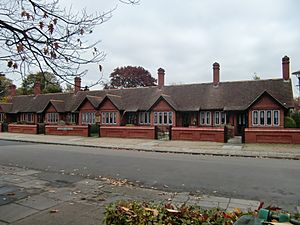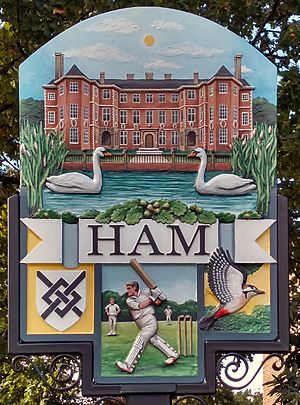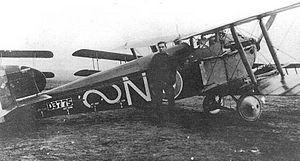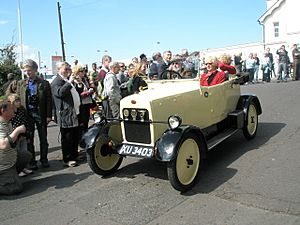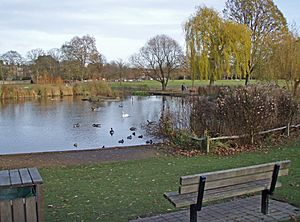Ham, London facts for kids
Quick facts for kids Ham |
|
|---|---|
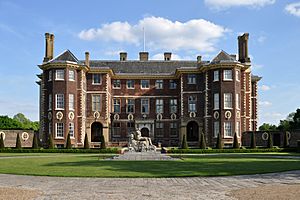 Ham House |
|
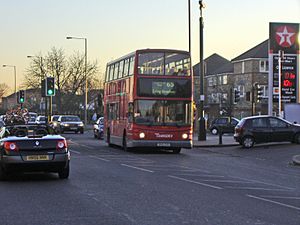 Housing by Ham Parade |
|
| Area | 9.26 km2 (3.58 sq mi) |
| Population | 10,317 (Ham Petersham and Richmond Riverside wards 2011) |
| • Density | 1,114/km2 (2,890/sq mi) |
| OS grid reference | TQ1813673150 |
| London borough | |
| Ceremonial county | Greater London |
| Region | |
| Country | England |
| Sovereign state | United Kingdom |
| Post town | RICHMOND |
| Postcode district | TW10 |
| Dialling code | 020 |
| Police | Metropolitan |
| Fire | London |
| Ambulance | London |
| EU Parliament | London |
| UK Parliament |
|
| London Assembly |
|
Ham is a neighborhood in south-west London, England. It is part of Richmond. Ham is known for its green spaces and meadows next to the River Thames. The Thames Path National Trail, a long walking route, also runs through here.
Most of Ham is in the London Borough of Richmond upon Thames. A small part is in the Royal Borough of Kingston upon Thames. Ham has local shops and places like a petrol station and pubs. However, bigger shops and businesses are found in nearby Kingston upon Thames.
Contents
Ham's Location and Surroundings
Ham is about 15 kilometers (9.25 miles) south-west of central London. It sits near a bend in the River Thames, which almost surrounds it. Ham is about 1.6 kilometers (1 mile) south of Richmond and 3.2 kilometers (2 miles) north of Kingston upon Thames.
The land in Ham is mostly flat, between 6 and 12 meters (20 to 39 feet) above sea level. Some parts, near Richmond Park, go up to 20 meters (66 feet). You can walk along the Thames Path National Trail here. A large footbridge at Teddington Lock connects Ham to Teddington. In summer, a special ferry called Hammerton's Ferry can take you across the river to Marble Hill House in Twickenham.
Ham is next to Petersham, Richmond Park, and the town of Kingston. Across the river are Teddington and Twickenham.
Natural Areas
To the west, along the River Thames, are old river meadows called Ham Lands. These are a Local Nature Reserve. Long ago, this land was used for grazing animals. Some parts were also used to dig up gravel. The last gravel pit is now a lake, connected to the river by a lock.
This area is home to the Thames Young Mariners site. It is a 4-hectare (10-acre) center for water activities. The riverside area is kept as a public space and nature reserve.
East of Ham is Richmond Park, where the land rises up. Small streams from this higher ground flow into a waterway. This waterway is called Latchmere Stream to the south and Sudbrook to the north. It mostly flows underground but appears in Ham Common. It then flows through Richmond Park and into Sudbrook Park Golf Course before going underground again and joining the Thames.
The Land Beneath Ham
Ham is built on an area called the London Basin. The ground here is mostly made of London clay. The flat areas near the river have gravel, sand, and clay. To the east, in Richmond Park, there are older gravel deposits. These were laid down between 240,000 and 400,000 years ago.
What's in a Name?
The name "Ham" comes from an old English word, Hamme. This word means "a place in the bend of a river." This makes sense because Ham is located near a bend in the River Thames.
Ancient Discoveries
People have lived in the Thames Valley for a very long time. Stone tools from the Palaeolithic period (Old Stone Age) have been found near White Lodge, Richmond Park. This shows that early humans lived in Ham. Later tools from the Mesolithic period (Middle Stone Age) and Neolithic period (New Stone Age) were also found.
Ancient burial mounds called barrows are on the hill overlooking Ham. These mounds are from 3500 BC to 900 BC. Many flint tools like axes, knives, and arrowheads have been found in Ham Fields. These tools were made from high-quality flint from the North Downs, not local river stones. This suggests that people lived here and didn't just pass through. Many of these old items are kept at the Museum of Richmond and the Museum of London.
Some pieces of Romano-British pottery from the late Iron Age (1st and 2nd centuries AD) show that people continued to live in the area. The first early Saxon settlement found in Greater London was a "pit-house" excavated in Ham in the 1950s. This suggests Ham was one of the first places settled by Saxon people in the 5th century AD.
Ham's Story Through Time
Ham is not mentioned in the Domesday Book of 1086, which was a big survey of England. The first written record of Ham as a separate village is from the 12th century. It was called Hamma and was part of Kingston.
From the 1600s, Ham began to change. Ham House was built in 1610. It is one of the best-preserved houses from that time. The history of the Earls of Dysart greatly influenced Ham and Petersham for the next 400 years.
In 1637, King Charles I enclosed Richmond Park. This meant Ham lost the use of over 320 hectares (800 acres) of land, almost half of which was common land. In return, a special agreement was made. This agreement has helped protect most of the remaining common land, Ham Common, to this day.
Until the late 1800s, the whole area was often called Ham cum Hatch (Ham with Hatch). Hatch was a small village near the north-east part of Ham Common. Ham itself was to the west and north-west, closer to the Thames.
Between 1838 and 1848, Alcott House was located on Ham Common. It was a special community and free school. Hesba Stretton, a famous children's writer, lived in Ham from 1892 until she died in 1912.
How Ham is Governed
Since 1965, most of Ham has been part of the London Borough of Richmond upon Thames. The rest is in the London Borough of Kingston upon Thames. These boundaries have changed a little over time.
In the past, Ham was managed by a local "vestry" from 1786. This group met in the New Inn because Ham didn't have its own church until 1832.
Later, a "Board of Guardians" was set up in 1834 to help the poor. Ham always had one or two representatives on this board. They mainly helped local people in almshouses (special homes for the poor).
In 1871, a local government board was formed. Then, in 1894, Ham became the Ham Urban District. It had an elected council of ten members. The area was officially renamed "Ham" in 1897.
In 1933, the urban district was removed. Ham became part of the larger Municipal Borough of Richmond. The boundary with Kingston also moved. Today, Ham is part of the Ham, Petersham and Richmond Riverside ward.
Ham's Economy
Farming in the Past
For many centuries, Ham was a farming community. There were meadows and pastures along the river, and common land for grazing animals. In 1842, about 182 hectares (449 acres) were used for crops like wheat, barley, and oats. Another 117 hectares (290 acres) were meadows or pastures. Animals like cows, sheep, pigs, and chickens grazed on the common land.
Ham had three farms, all owned by the Earl of Dysart. These farms were unusual because they kept the old "open field system" until the late 1800s. As London grew, farming changed from general crops to market gardening (growing vegetables for sale) by the early 1900s. Eventually, the demand for housing and the profit from digging gravel meant that farming in Ham stopped by the mid-1950s.
Gravel Mining
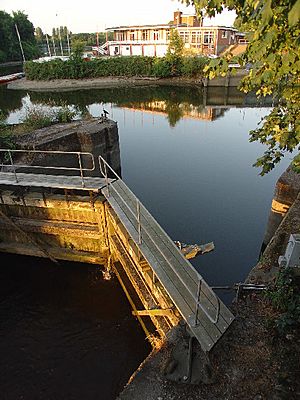
In 1904, part of the farmland was leased to the Ham River Grit Company Ltd. They dug up sand and ballast (small stones). A dock was built in 1913 and a lock in 1921. Parts of these are still there today as the Thames Young Mariners water activity center. A small railway connected the site to the main road.
During World War II, the flooded pits were thought to be used to store parts of the Mulberry harbour, which were special floating docks used in the D-Day landings. After the war, many pits were filled with rubble from bombed buildings in London. The pits operated until 1952. Some of the land was then used for new houses. However, local people fought against more building. This led to the area being protected as Metropolitan Open Land. This preserved Ham Riverside Lands as a nature reserve. The rubble underneath gives the area unusual plants.
Aircraft and Vehicle Manufacturing
Towards the end of World War I, land south of Ham Common was sold to build an aircraft factory. This factory, National Aircraft Factory No. 2, was built very quickly in 1917. The Sopwith Aviation Company used it to make many fighter planes like the Sopwith Snipe and Sopwith Dolphin. After the war, there was less demand for planes. Sopwith Aviation closed down and reformed as H. G. Hawker Engineering in Kingston.
The factory was then used by Leyland Motors. They first fixed up old army trucks. From 1922 to 1928, they made the Trojan Utility Car there. In the 1930s, the factory made Leyland Cub trucks. During World War II, it made military vehicles and other equipment. After the war, it produced parts for Leyland's trolleybus.
In 1948, the site was sold back to Hawker Aircraft Ltd. It became the main place for Kingston's aircraft industry. Many Hawker Hunter planes were made there because of the cold war. The factory was rebuilt in 1958 and became Hawker's UK headquarters. The Ham factory was very important in developing the Hawker Kestrel and Hawker Harrier planes.
After the aircraft industry was taken over by the government in 1977, British Aerospace continued to build Harriers there. The site closed in 1991 and was taken down in 1993. New houses were built on the land.
Paint and Varnish
In 1929, a factory was built across the road from the Leyland factory. This was for the Cellon Doping Company. They made a special varnish called Cellon aircraft dope to waterproof aircraft fabric. This company later became part of Courtaulds and then International Paint. The factory closed in the 1980s, and the site is now a small industrial area.
Ham Today
Today, Ham is mostly a residential area. Most people who live here travel to other places for work. There is one plant nursery and some local shops and small offices.
Important Places in Ham
The main feature in Ham is Ham Common. It has a cricket pitch, a pond, and a woodland area.
A straight path lined with trees leads from Ham Common to Ham House. This is the most important historic house in Ham. Part of the path is called Great South Avenue, and another part is called Melancholy Walk.
Many old and beautiful houses are around Ham Common. These include the Cassel Hospital, Langham House, and Ormeley Lodge. Beaufort House in Ham Street is from the 1700s and is a listed building. Grey Court School has a Georgian house called Grey Court House, now Newman House. John Henry Newman, a famous cardinal, lived there as a child.
In contrast, Langham House Close, built in 1958, is an early example of brutalist architecture (a style of building that uses raw concrete). Parkleys, a large housing development, was built between 1954 and 1956.
Ham has four churches: Ham Christian Centre, St Andrew's Church, St Thomas Aquinas Church, and St Richard's Church.
Getting Around Ham
Ham is served by three bus routes: the 65, 371, and K5. All these buses connect Ham to Kingston upon Thames. The 65 and 371 also go to Richmond.
Sports and Activities
The Ham and Petersham Cricket Club started in 1815. Cricket is still played on Ham Common.
The Ham Polo Club has a polo ground near Ham House. It has been around since 1926.
The Ham and Petersham Lawn Tennis Club has courts near Ham House, shared with Grey Court School.
The old meadows along the Thames near Ham House became a King George's Field in the 1930s. This 4-hectare (10-acre) area has facilities for cricket, football, and tennis.
The Ham and Petersham Rifle and Pistol Club started in 1907. It has indoor and outdoor ranges for archery, pistol, and rifle shooting.
The Kew and Ham Sports Association provides football and baseball fields between Ham House and Thames Young Mariners.
The Richmond Baseball and Softball Club plays its home games in Ham.
The Thames Young Mariners center offers sailing, canoeing, open-water swimming, and other outdoor sports.
Notable People from Ham
- Mitch Benn (born 1970), a musician, comedian, and author, lives in Ham.
- Christian Furr (born 1966), a royal portrait painter, lives in Ham.
- Lady Annabel Goldsmith (born 1934) lives in Ormeley Lodge. She raised her children there, including Jemima Khan, Zac Goldsmith, and Ben Goldsmith.
- Stephen Jakobi, a crime fiction writer and human rights lawyer, lives in Ham.
- Tony Lit, managing director of Sunrise Radio, lives in Ham.
Historical Figures
- Princess Marie of Orléans was born in Ham in 1865.
- Claude Bowes-Lyon, Lord Glamis and Cecilia Cavendish-Bentinck lived at Forbes House on Ham Common. Their daughter, Elizabeth Bowes-Lyon, later became Queen Elizabeth, the mother of Queen Elizabeth II.
- Nigel Dempster (1941–2007), a British journalist, lived in Ham.
- George Gale (1929–2003), a cartoonist, lived in Ham.
- James Goldsmith (1933–1997), a billionaire financier, and his family lived at Ormeley Lodge.
- Emily Hornby (1833–1906), a mountaineer and travel writer, died in Ham.
- John Minter Morgan (1782–1854), a writer and philanthropist, lived on Ham Common.
- John Henry Newman, later Cardinal Newman (1801–1890), spent some of his early years at Grey Court, Ham Street.
- Beverley Nichols (1898–1983), an English writer and playwright, lived at Sudbrook Cottage from 1958 until his death.
- Sir George Gilbert Scott (1811–1878), a famous architect, lived at the Manor House in Ham Street.
- Hesba Stretton (real name Sarah Smith; 1832–1911), a children's writer, retired to Ham Common in 1892 and died there in 1911.
See also
- List of schools in Richmond upon Thames



